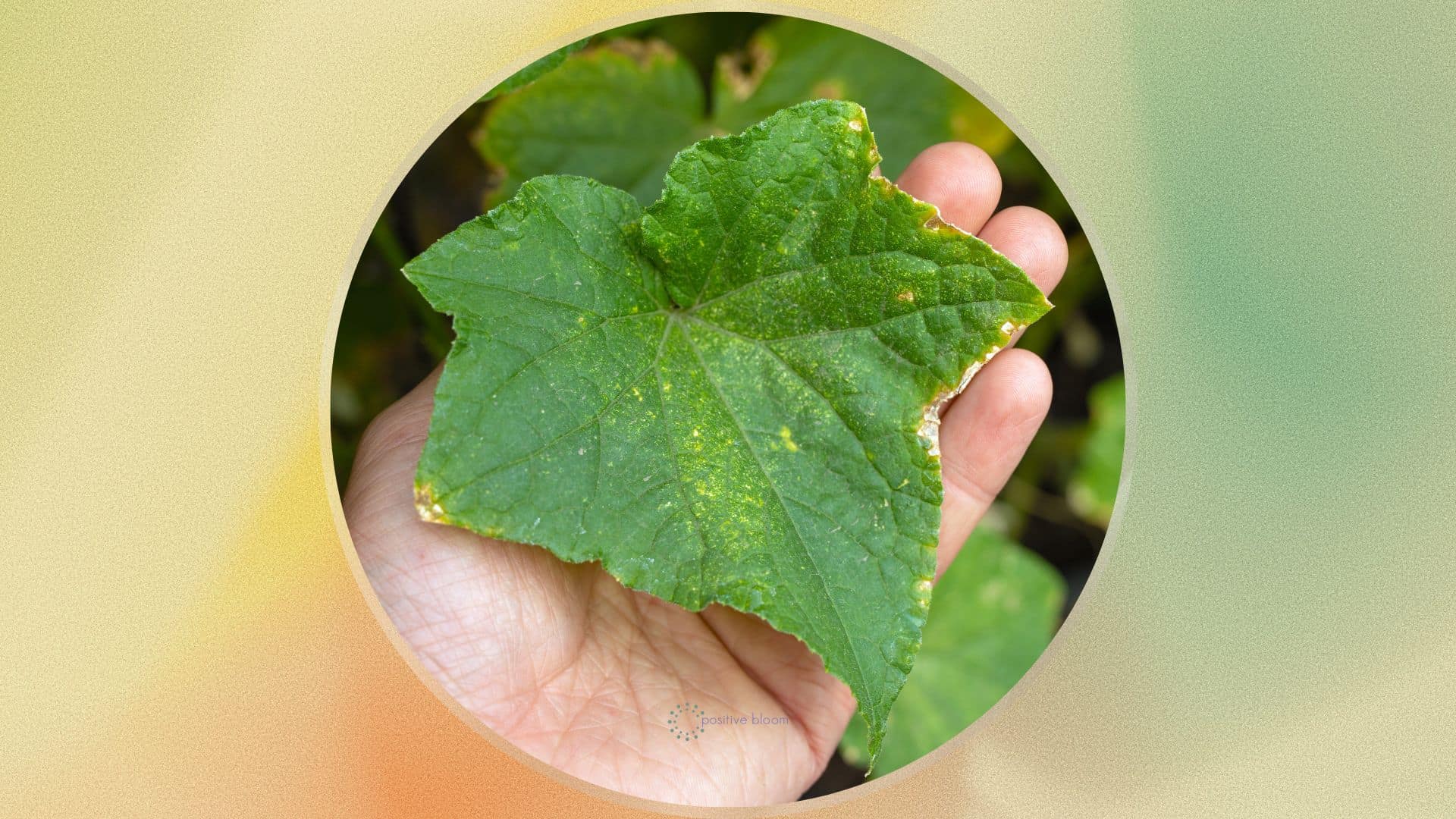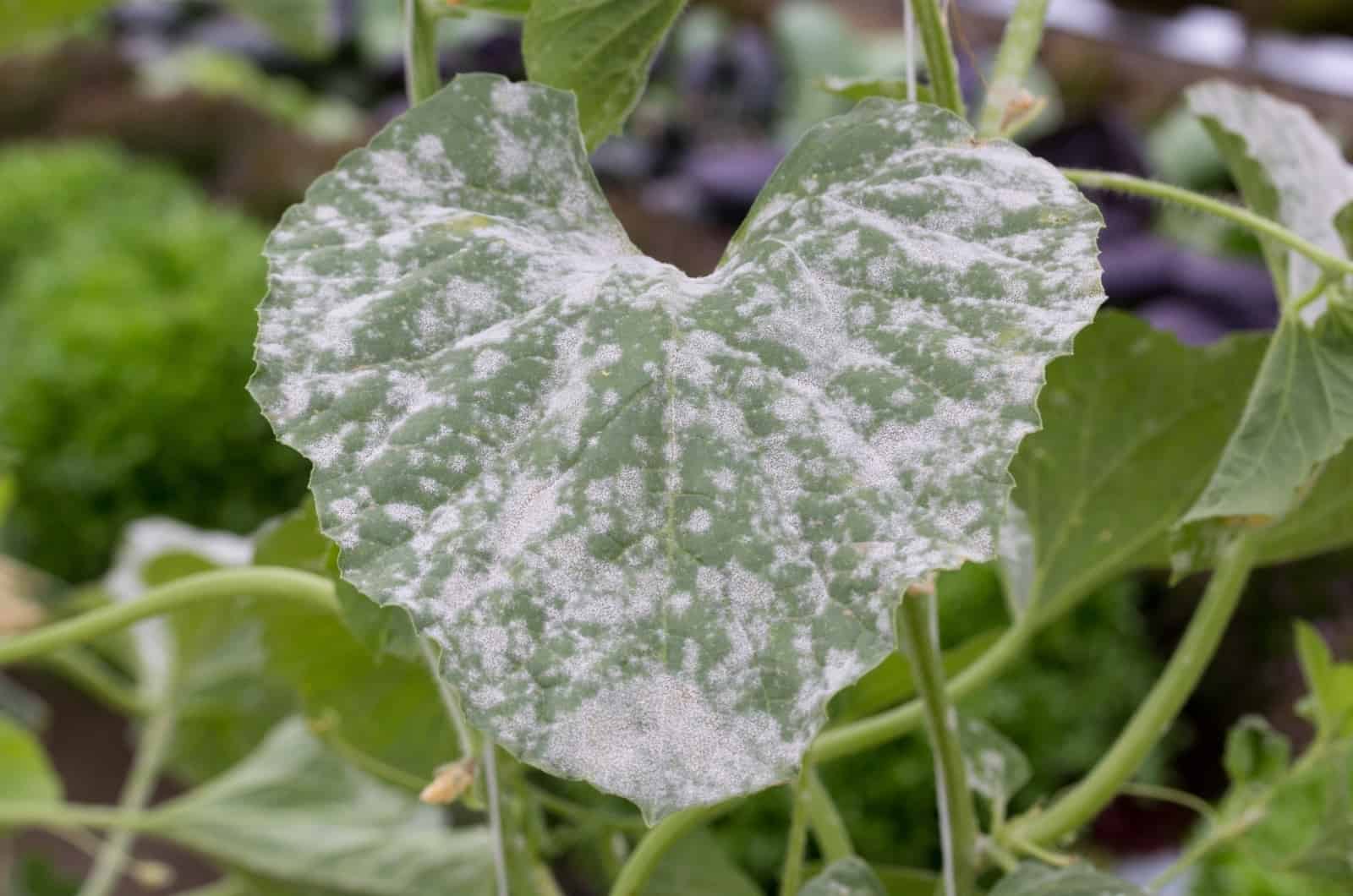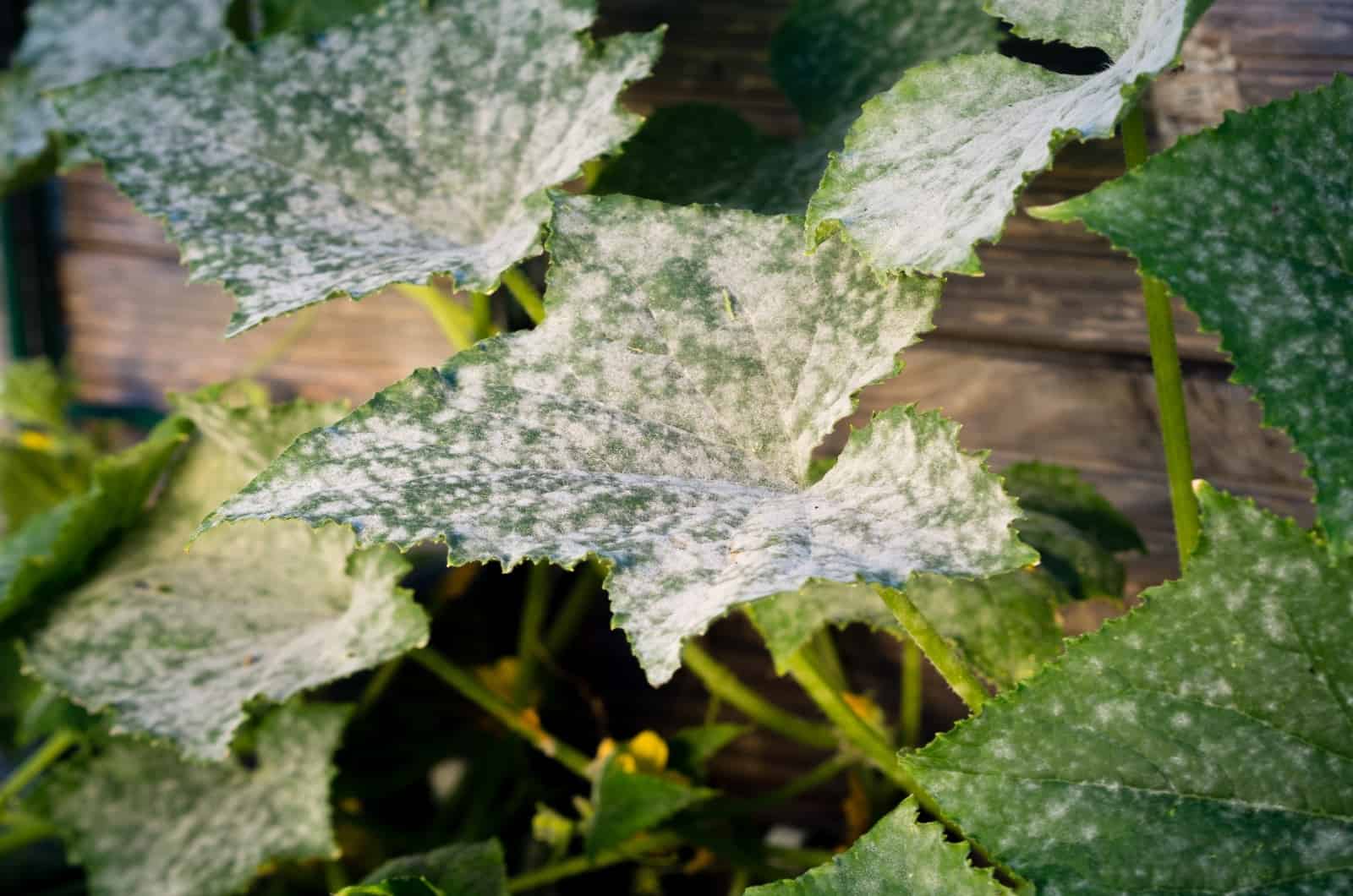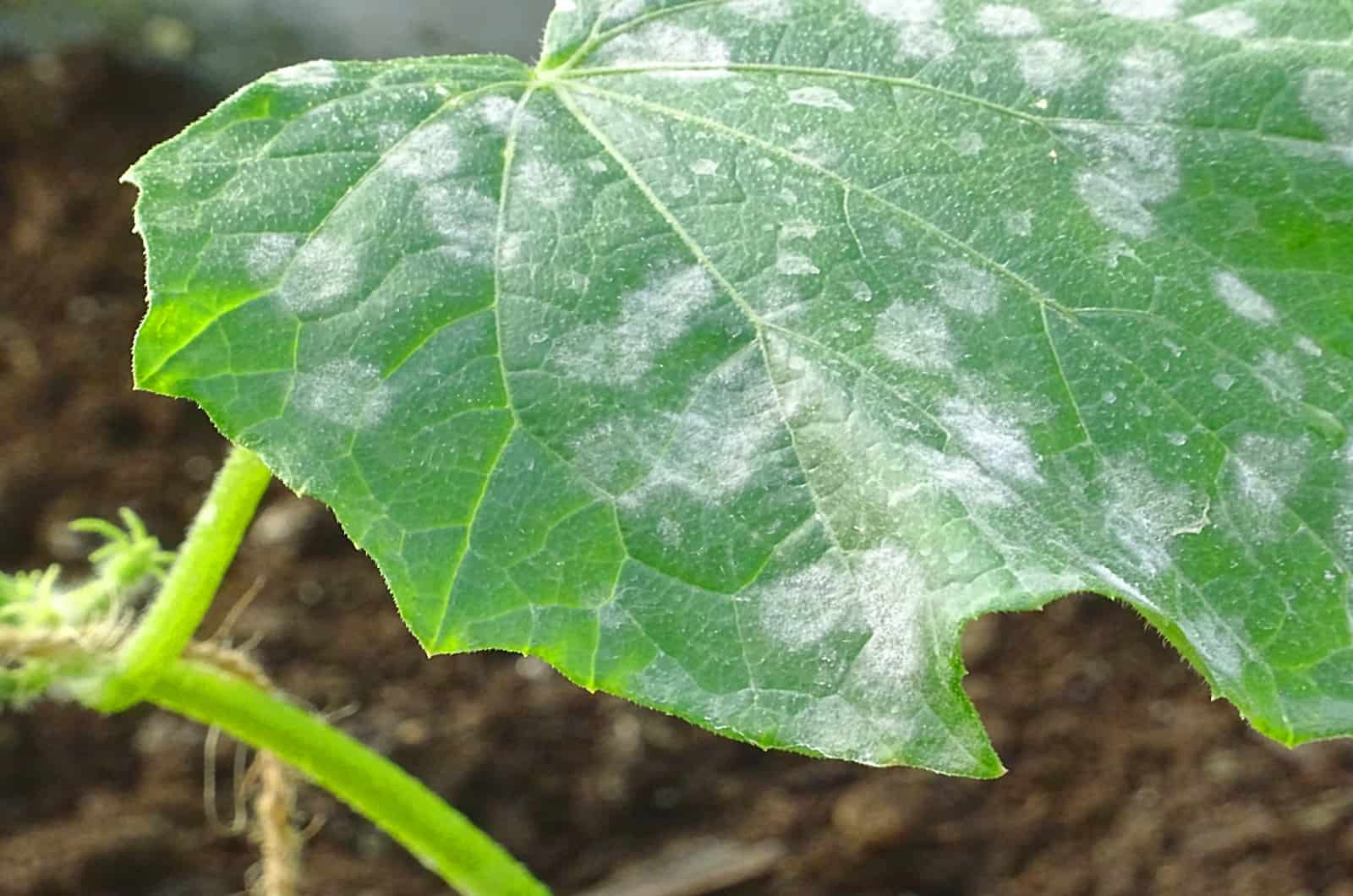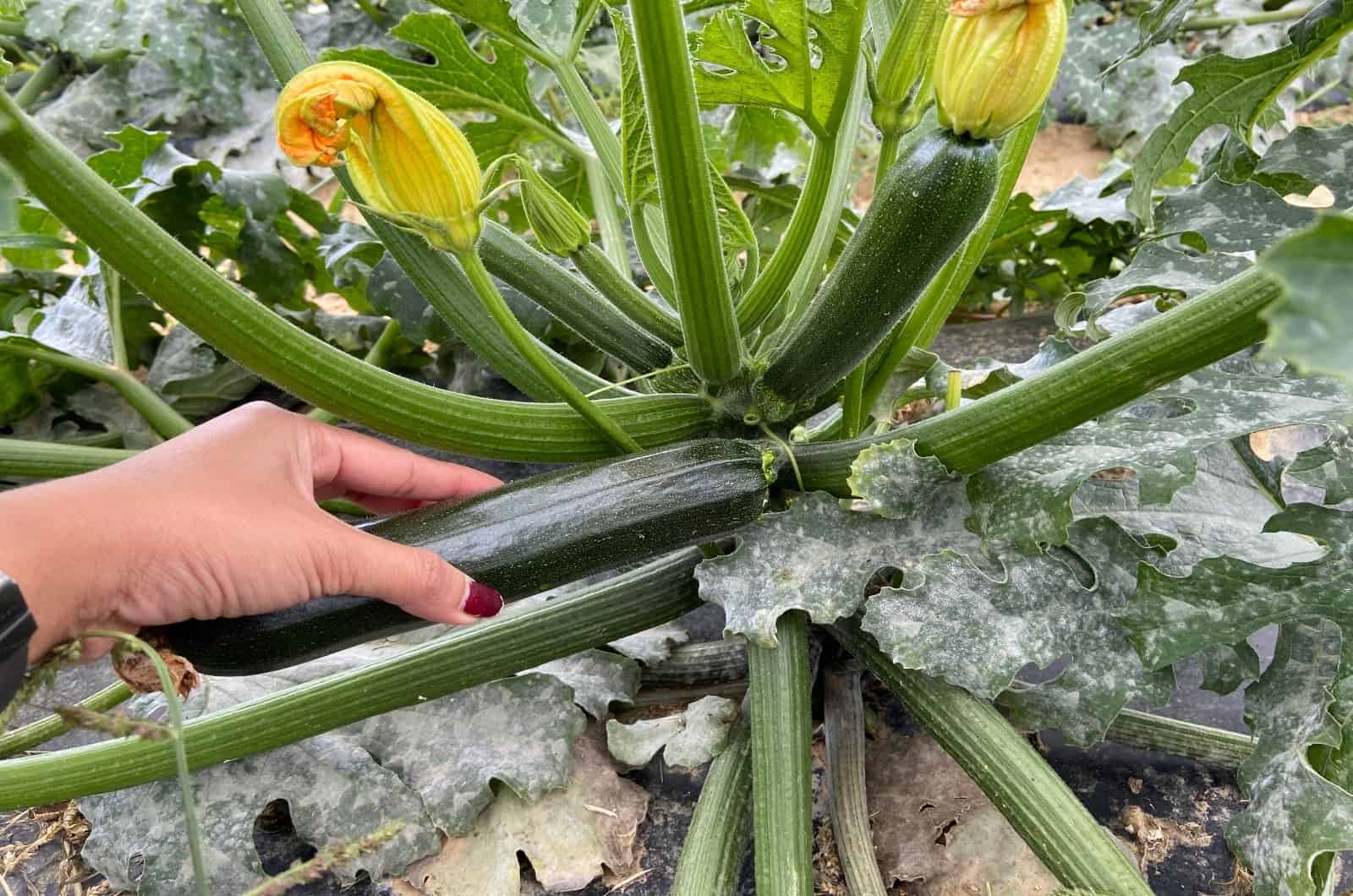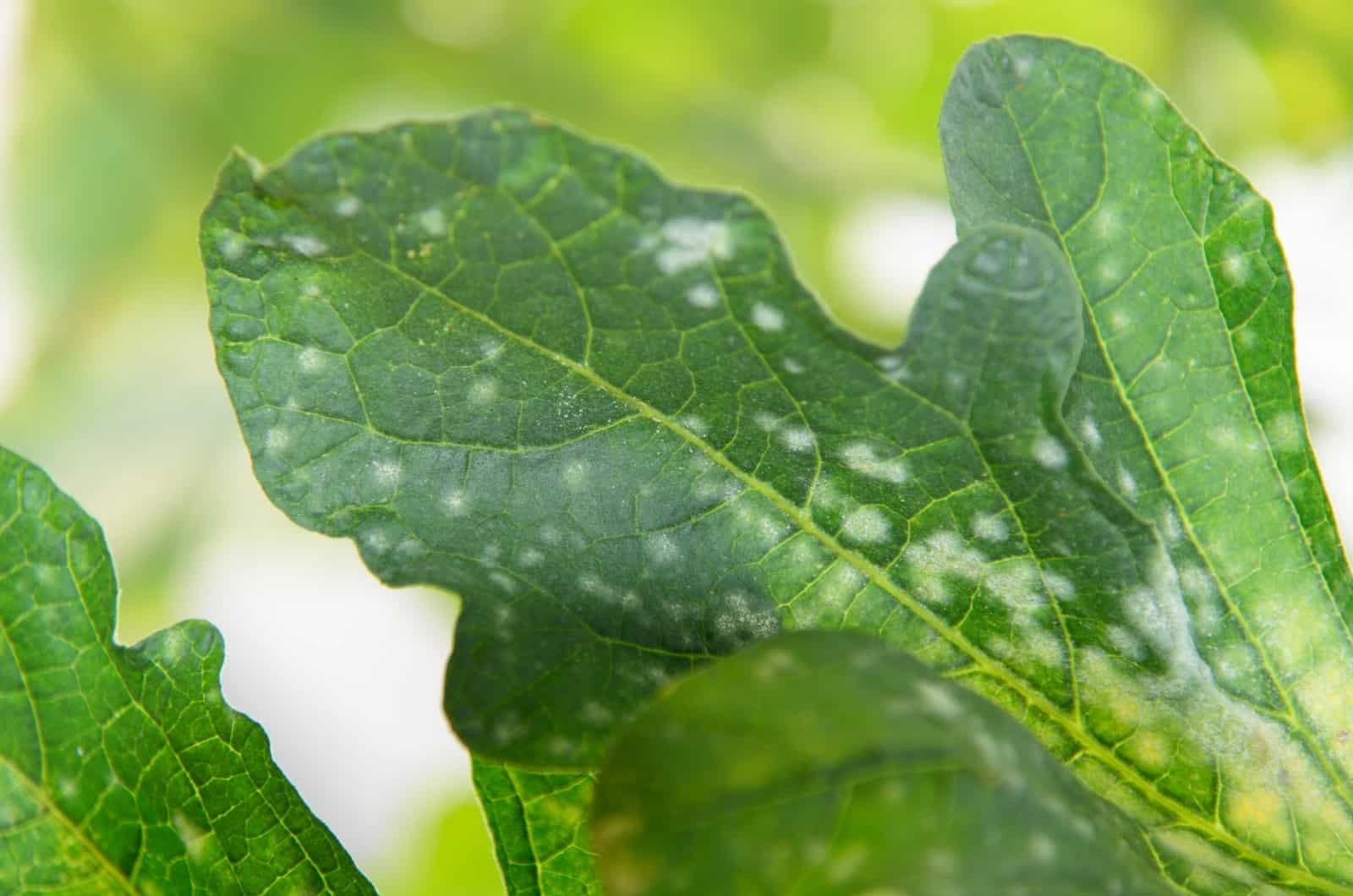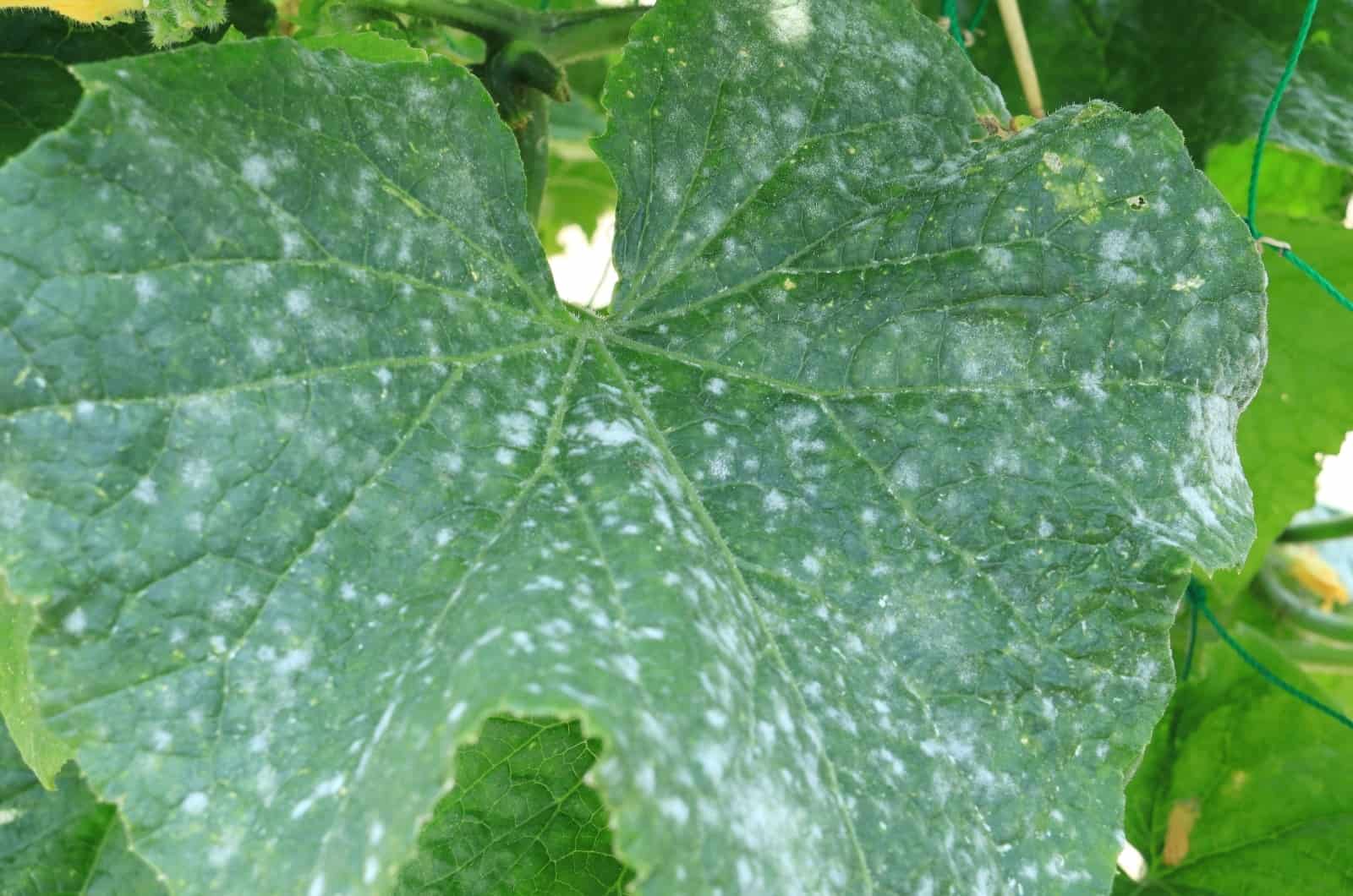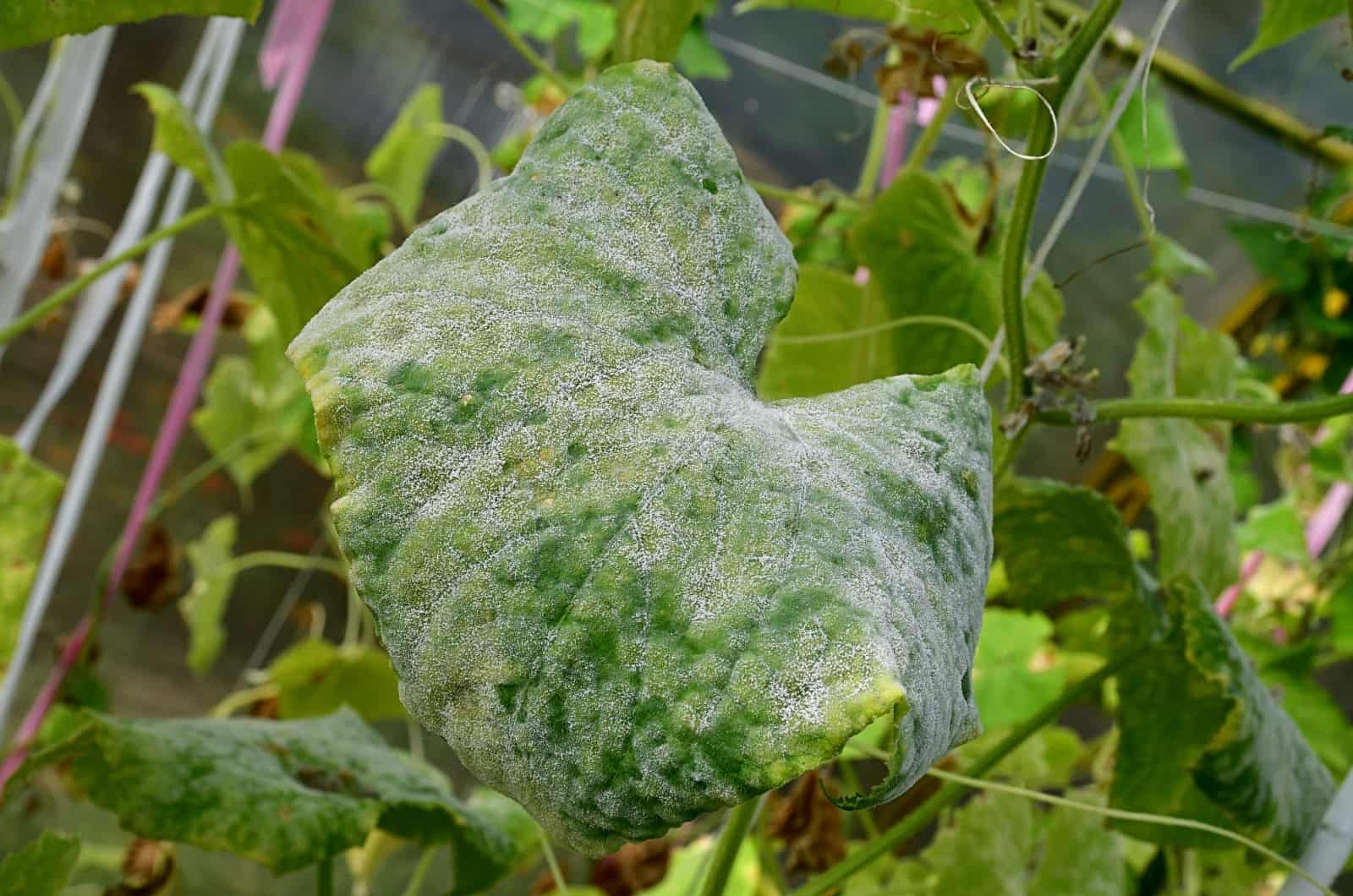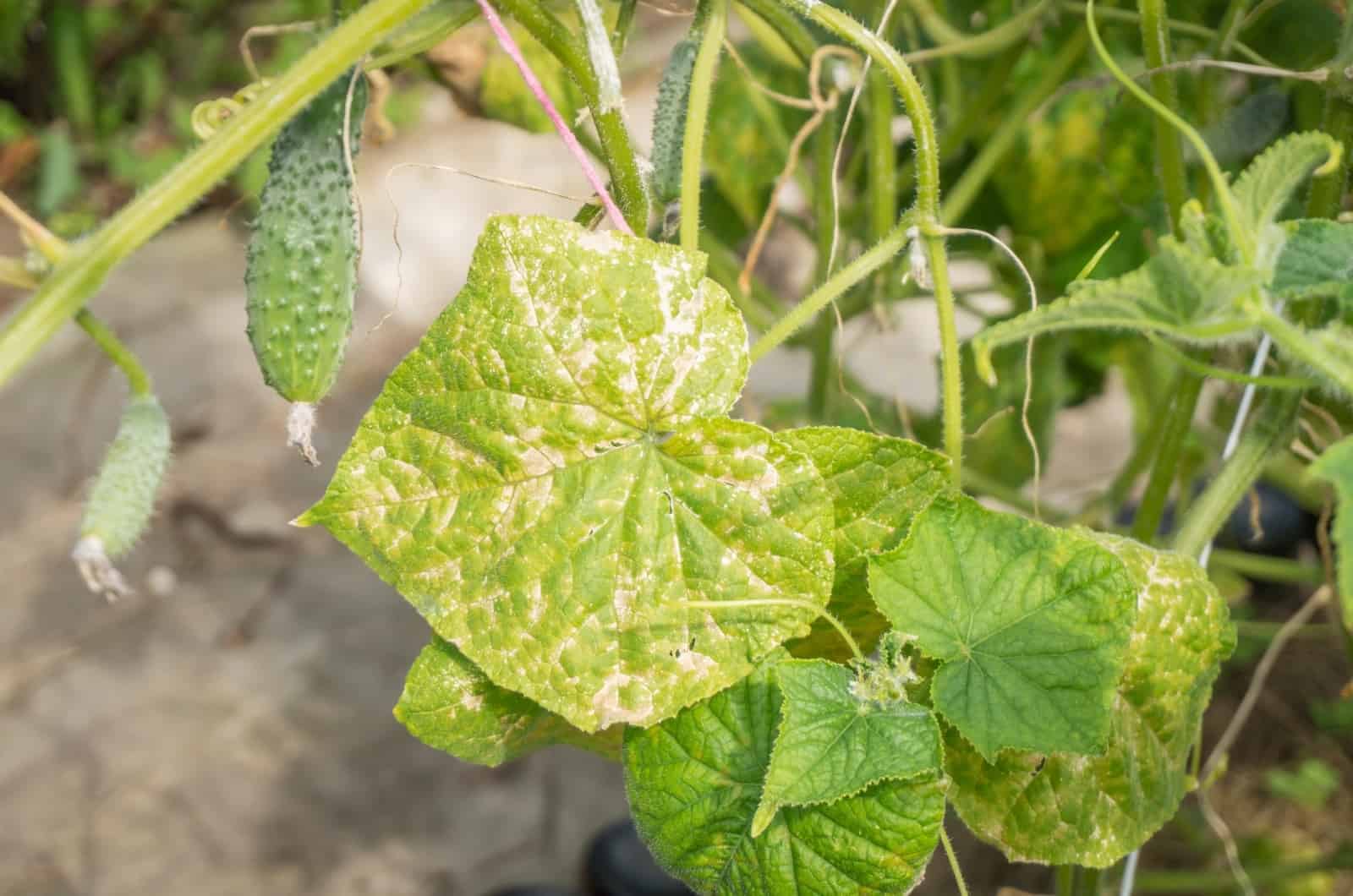No one likes to see changes to the structure and color of their precious veggies. Delicious cucumbers are undoubtedly one of the easiest veggies to grow in a home garden, but they aren’t problem-free, especially if the conditions you provide are incorrect.
What does this mean? Enough light, proper temperatures, and adequate watering and feeding are all factors that contribute to the development of healthy cucumber plants.
White spots on cucumber leaves are actually a pretty frequent occurrence.
In this article, I’ll tell you more about the causes of white spots, how to get rid of them, and, of course, how to prevent them from happening.
Let’s get started!
Causes Of White Spots On Cucumber Leaves
Surprisingly, there’s only one reason for white spots on cucumber leaves; powdery mildew, a disease that affects many veggies, including cucurbits, legumes, and nightshades.
Let’s learn more about this fungal disease, what causes it, and some other signs that indicate a powdery mildew infection.
More About Powdery Mildew
The disease isn’t caused by a single fungus species. Here’s a list of a few species whose presence may result in white spots on the leaves (powdery mildew).
1. Erysiphe (Erysiphe cichoracearum): Host plants of this fungus belong to the Brassicaceae and Cucurbitaceae families.
2. Leveillula: Host plants include some nightshades, such as peppers, tomatoes, and eggplants, and other plants like cotton.
3. Microsphaera: This fungus causes disease in species from the Rosaceae family.
4. Sphaerotheca: Cucurbits, strawberries, chamomile, and Cineraria plants are most susceptible to this fungus.
5. Podosphaera: This is the primary cause of powdery mildew in cucurbits, and a major global production constraint for these veggies.
How Does It Spread?
The fungal spores of the disease are wind-borne. Believe it or not, a plant can be miles and miles away from the host plant and still get infected.
Other transmitters of this disease include pests such as mites.
The main problem is that these spores quickly germinate on affected plant species, and the infection starts spreading in a short period.
The thing is that this fungus doesn’t require moisture to thrive in some cases.
Fungal growth occurs on the cucumber leaves as the spores pierce the tissue of the plant to absorb nutrients.
As soon as the wind blows, it disperses these fungal spores after they break off.
High humidity and cooler temperatures encourage the growth of spores, whereas high temperatures and poor air circulation aid in spreading.
60 to 80 degrees Fahrenheit is the ideal temperature range for fungus spores to spread.
Cucumbers are delicate plants that are susceptible to stress brought on by underwatering, not enough light, or pest infestation.
If this happens, the chances of powdery mildew significantly increase.
Surprisingly, frequency of watering has a significant impact on the development of mildew because it can develop as long as the leaves of your cucumber are soggy.
Other Signs Of Powdery Mildew
You know what they say, misfortunes never come alone. Well, that’s exactly what’s happening here. White spots are not the only symptoms or consequences of powdery mildew.
The first thing to discuss is the photosynthetic cells on the leaves of your cucumber. After the plant is infected, the disease will cover the cells on the leaves and prevent them from getting sunlight.
As a result, cucumber plants are unable to produce chlorophyll and begin to starve. The most common outcomes are wilting and decreased growth rate.
Unfortunately, your cucumber can die if the disease spreads too much or you don’t treat your cucumber on time.
The disease can occur at all growth stages of cucumber plants.
Will Other Plants Get Infected?
If your cucumber suffers from this disease, many plants in your home garden can also be infected.
What does this mean? If you grow other cucurbits, such as melons or zucchini plants, they’re also susceptible, and the spread of powdery mildew spores will continue down the road.
Additionally, some nightshades such as potatoes, tomatoes, and eggplants, are also sensitive to disease, as well as some flowering plants such as Begonias and roses.
Many plant growers make a huge mistake and plant these plants in the same growing medium after they remove the affected cucumbers.
Bear in mind that the fungi thrives in soil, so you won’t destroy it by taking the plant out.
Although some plants aren’t sensitive to this disease, I would still avoid planting them in the same soil; you can’t be too careful!
How To Get Rid Of Powdery Mildew/White Spots On Cucumber Plant Leaves
A powdery mildew infection doesn’t always end with the death of your cucumber plant. Actually, if you address the problem in time, you can quickly save your cucumbers.
Fungicides should be your last resort as they can harm the growing medium, nearby plants, beneficial insects, and pollinators.
I’ll show you a couple of DIY methods you can use to treat powdery mildew.
Some Natural Ways To Get Rid Of This Disease
If you notice your cucumber leaves are affected, here’s how to remove the powdery spots.
Baking Soda
The first method you can use is making a baking soda solution. All you need to do is add 1 tbsp of baking soda to a gallon of water.
Pour the solution into a spray bottle and apply it to the cucumber leaves.
Another way to use baking soda as a treatment for powdery mildew is to dilute 4 tbsp of it in a gallon of water and add about 2 tbsp of vegetable oil.
I must mention that this method won’t work if the temperatures are too high. Apply a baking soda solution when temperatures are lower than 85 degrees Fahrenheit.
Milk Spray
I’m sure you’ll be surprised to hear that you can use milk to treat powdery mildew on cucumber leaves.
Although milk acts more as a preventative measure, it is worth trying to treat the disease.
Many growers recommend using a 40:60 ratio of milk and water. However, you might want to test out various ratios to determine how effective they are. Pour the solution into a spray bottle or garden sprayer.
Spray the cucumber leaves with the milk solution when the full sun emerges.
I recommend spraying the solution every two weeks for the best results. Don’t hesitate to treat healthy plants with milk solution; you’ll decrease their susceptibility to powdery mildew and get rid of the disease on the affected leaves of cucumber plants.
Neem Oil Solution
Neem oil functions as a fungicide and is very effective for powdery mildew on cucumber leaves.
Neem oil won’t get rid of mold infections right away, though. Remember that this kind of fungicide won’t work on serious infections.
Neem oil can burn the leaves if you don’t pay attention to dosage and application.
The first thing you need is pure neem oil. You can dissolve 1 tbsp of it in a quart of water for the best results. The great thing is that you can use this foliar spray to fight pests on your cukes.
Row Covers
As mentioned, some pests can transmit powdery mildew disease. You can place row covers on cucumber seedlings to deter larger pests, such as leafhoppers.
As you might assume, this method won’t prevent smaller insects, such as mites and aphids.
Also, cucumber plants need a lot of direct sunlight to enter the flowering growth stage, so you’ll need to get rid of the row covers at this stage.
If the infection is still present, you need to consider using other methods for treating it.
When To Dispose Of Your Cucumber Plant
Unfortunately, you’ll need to discard your cukes in some cases.
If the disease spreads and your cucumber plants start showing signs of serious distress, I highly recommend discarding entire plants.
You won’t be happy to hear this, but you’ll need to remove all the plant species in your garden that are susceptible to powdery mildew disease.
The first thing you need to do is take your cucumbers out of the soil. Then, get rid of the surrounding soil.
You need to replenish the soil and add organic matter. If you have a compost pile, you can use it after you take your cucumbers out.
Remember, the soil for cucumbers has to be well-draining and contain ingredients that aid airflow.
Many growers have asked me if they can add the cucumbers they removed to their compost pile. Fungus might not grow on dead plants, but it can overwinter and affect other plants once you use the compost.
How To Prevent Powdery Mildew
We can discuss treatment and possible outcomes of powdery mildew all night, but one thing is for certain, prevention is the key!!!
There are several excellent methods to prevent this disease in cucumber plants.
Let’s see them.
Start With Disease-resistant Varieties
The great thing is that we can find some disease-resistant varieties of cucumber plants.
For example, you can find delicious round cucumber varieties, such as cucamelons, that are disease-resistant.
Adam Gherkin, Carmen, Burpless hybrid, Darlington, and Sweet slice are just some of many cukes resistant to powdery mildew.
If you’re unsure, search for cucumber seed packets that have a PM (powdery mildew) label.
Ensure Enough Space
Correct spacing between plants is essential because of air circulation. If you are planting your cucumbers in rows, the spacing should be about 4 feet.
If you are starting your cukes from seeds, you need to leave approximately 6 inches between each one.
Thinning your cucumber seedlings can also enhance air circulation.
Cucumber leaves will be less susceptible to white spots if their leaves aren’t touching each other.
Attaching cucumber vines to a trellis can aid airflow.
Choose The Ideal Spot
Similarly to other common garden veggies, cukes need at least 6 hours of sunlight a day.
First, direct sunlight promotes the water evaporation rate, so the plant won’t retain excess moisture and create an environment for fungi.
Plants can’t perform photosynthesis if they don’t receive enough sunlight. Fungi that affect cucumber plants thrive in darker conditions, so give your cukes enough light to avoid infections.
Once you’ve found the ideal spot for your cucumber plants and they can receive at least six hours of direct sunlight each day, pay close attention to the lowest leaves.
These leaves receive the lowest amounts of light due to their position, so they’ll be more susceptible to powdery mildew because water from their leaves will evaporate slower.
The easiest way to avoid it is to inspect the cucumber leaf surface regularly.
Use Mulch
Mulch protects against extreme heat, helps the soil retain moisture, prevents waterlogging, and stops weed growth.
You can use a variety of materials as mulch, such as coconut coir and organic components.
Grass clippings are also good mulch material. For the best results, apply a layer of mulch that is ideally 2-3 inches thick, regardless of the type you decide on.
Water Properly
The irrigation system can help you solve watering issues. If this is impossible, you can use a proper watering technique to avoid problems.
When watering your cucumber plants, pour water only at the base of the plant. The entire leaf should always be dry. I use a soaker hose for cucumber irrigation.
Make sure you use a well-draining growing medium, as waterlogging can cause cucumber leaves to turn yellow.
Pay attention to the watering schedule after transplanting, as too much or too little water can contribute to transplant shock.
Companion Planting
Growing cucumbers near other plants can help you avoid pests and diseases. Companion planting helps all plants that are grown near each other.
For example, you can plant cucumbers near chamomile as a companion plant. Chamomile repels pests that frequently attack cucumbers and enhances the growth and taste of cucumber plants.
Dill is another great companion plant for cucumbers as it deters pests and improves taste, just like chamomile.
Wrapping Up
Cucumbers can be affected by a few pests and diseases. The leaves are typically what suffer the most.
If you expected a lot of different reasons for white spots on cucumber leaves, I’m sure you are now pretty surprised.
Well, the number one cause of this cucumber issue is the notorious powdery mildew. It’s essential to know how it occurs and how it spreads.
You’ve seen what enhances fungal spore spreading, so if you can’t save your cucumbers at this point, you now know how to prevent it in the future.
Full sun, well-draining soil, adequate spacing, and disease-resistant cucumber varieties can help you avoid powdery mildew and other issues related to the growth of these delicious veggies.
Until next time!
Like this post? Share or pin it for later!

